football hmmm
"Every football team eventually arrives at a lead play: a "Number 1" play, a "bread and butter" play. It is the play that the team knows it must make go, and the one its opponents know they must stop. Continued success with it, of course, makes your Number 1 play, because from that success stems your own team's confidence." –Vince Lombardi
As we discuss coaching candidates we'll invariably get into the same old discussions on what kind of base offense said candidate might want to run. There was some discussion on the board this week and I wanted to expand that discussion into some basic "Rock" plays of various offensive schemes.
It is incorrect to identify any one play (and even more incorrect to identify a specific formation or personnel group) as a complete offense. You always need counters to keep doing the thing you do, and the counters will often borrow directly from some other offensive concept's rock. All offenses will borrow from each other so no breakdown is going to describe more than 60% of any given offense. Most zone blocking offenses throw in man-blocked things (example: inverted veer) to screw with the defense. You can run most of these out of lots of different formations. You can package counters into almost all of them (example: The Borges's Manbubble added a bubble screen to inside manball).
Really what you're describing when you talk about any offense is the thing they do so well that they can do it for 5 or 6 YPP all day long unless defenses do something unsound to stop it (like play man-to-man, or blitz guys out of coverage, etc.). Some examples of offenses and their formation needs (where a need isn't specified, figure they can use any set or formation: spread, tight, 23, ace whatever). I've given the rock plays, and left out the counters and counters to the counters because that gets into way too many variants.
Finally, the terms "pro style" and "spread" are meaningless distinctions. NFL offenses have the luxury of getting super complex: they have passing game coordinators who teach the QBs and WRs Air Raid things then run zone or power blocked things. The spread refers to formations and personnel—it doesn't say anything about whether the QB runs, if it's an option offense, or what tempo it runs at, or even what kind of blocking it uses. What I've done here is break up the offenses into "QB as Run Threat" and "QB Doesn't Have to Run" since the construction of these base plays usually stems from that. Remember, however, that QB running offenses can (and often do) still use blocking right out of Vince Lombardi's favorite play.
QB as Run Threat Offenses:
Triple Option
The FB dive will hit too quickly for anyone but the DE to stop; once the DE bites, the RG moves down to the second level while the QB keeps and heads outside, with the RB in a pitch relationship to defeat the unblocked defender there.
Concept: QB makes a hand-off read then a pitch read.
Makes life especially hard on: Edge defenders who have to string out plays against multiple blockers and maintain discipline.
Formation needs: Two backs.
Helpful skills: QB who can consistently make multiple reads and won't fumble, highly experienced, agile OL, backs who can both run and bock.
Mortal enemy: The Steel Curtain. Stopping the triple option is a team effort; if everybody is capable of defeating blocks, challenging ball-carriers, and swarming to the pitch man there's nowhere to attack.
Examples: Air Force, Nevada, Georgia Tech, Bo's Michigan
[Hit the jump for ZR, QB power, Air Raid, West Coast, Manball, Inside Zone, and the Power Sweep].
Tom always MIKEs before he hikes.
We here at MGoheadquarters recently received some disturbing news about today's youth:
Devin Gardner on SiriusXM: "Before coach Nuss got here, I never had to identify a MIKE ... now I know where pressure's coming from."
— Nick Baumgardner (@nickbaumgardner) August 20, 2014 Kids these days are running around playing three or four years of Division I FBS major conference Block-M-Michigan football without ever identifying the MIKE. !. This sudden revelation has caused widespread histeria. Al Borges has been fired 180 times in the last several hours, and right now Dave Brandon and key personnel are closed off with Rich Rodriguez, deciding whether he needs to get a superfluous extra axe as well. This is calamitous. Catastrophic. Grievous. Pernicious. Regrettable. And avoidable.
What in the name of Double-Pointing Brady Hoke are you people talking about?
MIKE (v.): The act of identifying the middle defender inside the box on the 2nd level for purposes of establishing protection assignments.
It's basically calling out the defense's alignment, using a very simple mechanism: declare one linebacker—the one in the middle of the defense—to be a fifth guy that the five linemen are responsible for blocking.
 |
| Chad always MIKEs before he hikes. |
This is often, but by no means always, the middle linebacker, which many defenses call a "Mike," which is where the term comes from. This is important: the [guy playing the defensive position called] Mike doesn't get to be all-time MIKE. In fact the very reason we MIKE is because Mike the Mike might not be the MIKE, and not knowing this might get your quarterback very badded.
Why is MIKEing important to my children?
Because if the MIKE blitzes there's no way for outside protection to pick him up, so the offensive line has to assign everybody's blocking with that guy accounted for somehow. Defenses LOOOOOOOOVE to screw with this because that's how you get unblocked blitzers, and unblocked blitzers right through the heart of the OL are the best!
When the defense screws with you, you don't have time to point at everybody and say "you block him; you block him." So ONE guy calls out the MIKE and everyone else in the blocking scheme already knows what that means. Usually they call out what sounds like a playcall—it's just a blocking call. "Tango!" "Lightning!" "Red!" "Green!" "Taupe Carpet!"*
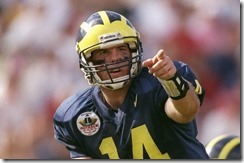 |
| Brian always MIKEs before he hikes. [James Squire|Getty] |
Like in running, pass pro can be man or zone (slide protection). Man makes sure every defender who could be blitzing has a guy assigned to block him (or as is often the case, a man who checks one guy then looks to another). In zone they're blocking gaps: A gap, B gap, C gap, etc. Whatever protection scheme, they have to "declare the MIKE." What they do from there depends on the scheme.
----------------------
* My dad used colors/nonsense words for playcalls: Blue Jumbo, Yellow Turbo, Purple Eskimo etc. Since he didn't like to use the same "play" twice he got pretty deep into the crayola box before parents' complaints in re: his Lombardi cigar ended his coaching career.
----------------------
[After the jump, Y U NO MIKE, DG?, and you learn to MIKE]
left: Upchurch, right: Fuller, not Jamar Adams.
After last week's roundtable, Heiko and I got into an argument over which safety position Gordon will play this year, and whether we've all been wrong to assume that the "Kovacs position" was indeed going straight to Jarrod Wilson. Let's investigate that.
Terminology
Through various defenses this site has covered, I have kept defaulting to "free" to describe whatever guy is the deep man, and "strong" to refer to the one who typically plays up. With Mattison's—I'm sorry—Michigan's defense these days those terms are becoming such misnomers that we may want to stop using them.
Michigan aligns their safeties to the boundary, not the strength of the formation, so "strong" and "weak" stuff for Michigan's D usually means "field" and "boundary."
Using monuMental's program again. Beyer is at SAM just to avoid Gordonian confusion
With the offense on its left hash the "strong" side is to the field. Here's where you need your more athletic guys who can cover more ground. When the offense is on the opposite hash Michigan flips the personnel:
Everyone knows where to go as soon as the ball is placed, and then they'll move around to match what the offense shows. Whatever the offense may gain from constantly shifting the strength of their formation opposite what Michigan aligns to, the expectation is they'll lose that by squeezing their space.
The front seven isn't so predictable; most often they will align so that the strong side is with the Y tight end—usually the "strong" side of the formation—to preserve the appropriate matchups. However when the formation flips the safeties hardly ever go with it. The coaches have said they want the safeties to eventually be interchangeable, though with such a disparity in makeup between Kovacs and any other guy on the roster the roles have been more defined. The biggest change from 2011 to 2012 was Kovacs did progressively more and more in coverage. You could see it in the dramatic shift in Kovacsian tackles as the linebackers got better.
For the safeties this means the actual "strong" safety will align to the field. He'll have more space to cover and also more guys to deal with. He's more likely to end up one-on-one with a slot receiver. The boundary safety will be more likely to draw a tight end or someone out of the backfield.
What was Kovacs Last Year?
Kovacs was the boundary safety. He aligned to the weak side and usually lined up a few steps closer to the line of scrimmage than did Gordon. Here's screencaps from the first two plays of the Outback Bowl to illustrate:
First snap:
Second snap:
That's not to say this was written in stone. Two snaps later SC aligned with trips to the strong side and Gordon came up to take away anything short and easy for the slot receiver:
No, the TE is not allowed to line up two yards behind the L.O.S. #SEC #CHEATERS
This screamingly illegal formation was a touchdown as Ryan and Gordon both followed the inside slot. Kovacs took the middle guy's post route and Raymon Taylor ended up 1-on-1 with the outside receiver and got burned.
This is a thing SC did a lot of in order to shift Michigan's defenders out of their core competencies. On the defensive last play of the game Kovacs again ended up the overhang guy where his speed deficiency could be exploited. You know how that ended. They weren't the only ones, though Michigan didn't always react the same way:
Same safety positions: Gordon is the deeper guy on the field side of the ball and the strong side of the formation—the position that's called "FS" on your EA Sports game—and Kovacs is the short, boundary guy that your game would call "SS." Note this time the front seven flipped so Morgan ended up over Eifert and Roh/Ryan were to the side of the Y tight end. So nothing is exact, but even when the formation flipped the safeties stuck to their roles. With the WLB to his side Gordon backed out to show Cov2 and ND ran a counter-right which picked on Clark; the linebackers shut it down.
Simple form: Kovacs was the boundary safety, Gordon was the field safety. What about this year?
What is Gordon This Year?
Sorry Heiko, but I think Gordon is still the nominal field safety. Here's the first snap of the 2013 Spring Game:
Gordon's the field, Wilson's the boundary. Jarrod Wilson has apparently inherited the Kovacs position while Gordon remains what he was. But something has changed. Spring Game play the fifth:
Yeah the front seven is flippy again but the safeties aren't: that is Gordon who has come up over the right TE (Williams) and is telling Wilson to "get back, get back!" Wilson then backed out of the screen. Now, the safeties switched roles plenty last year, but over the course of the Spring Game, I saw Wilson the overhang man more often than not, and this wasn't because the offense was overloading one side or another. I mean, this is a pretty straightforward Ace 2TE set.
So while Gordon's position hasn't changed, his role may have. Kovacs last year would often come down then have a deep cover responsibility. Or he'd be given complicated reads and be responsible for changing coverages on the fly much as an Air Raid offense changes receivers' routes based on what the defenders are doing after the snap. That's because he's Kovacs. The expectation this year is that Gordon will be doing much more of the fancy stuff while Wilson's job on most plays will be to not let anything over his head. The more Jarrod progresses, the more Michigan can have him do the fancy Ed Reed things and the less predictable the defense will be. Wilson may have taken Kovac's position, but for the most part Gordon has his job.
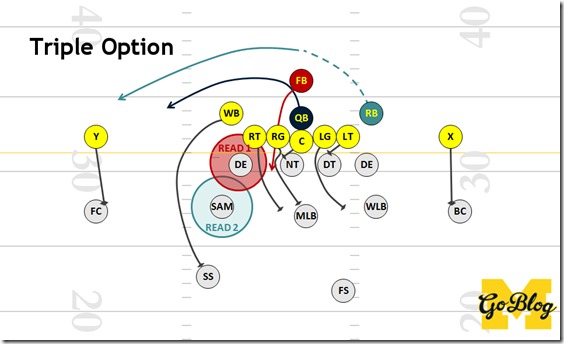
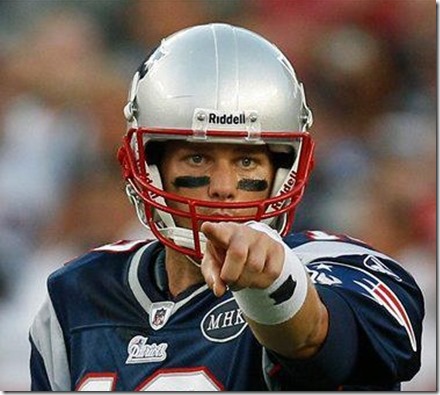

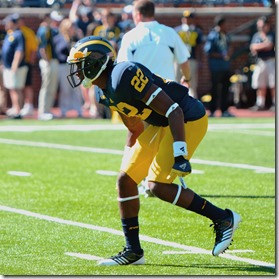
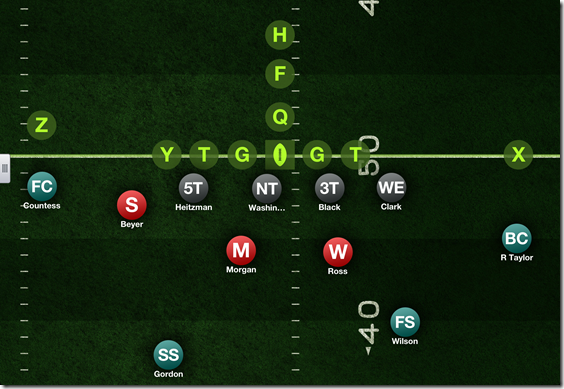
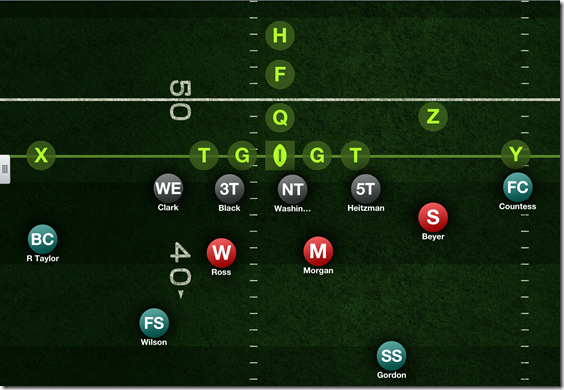

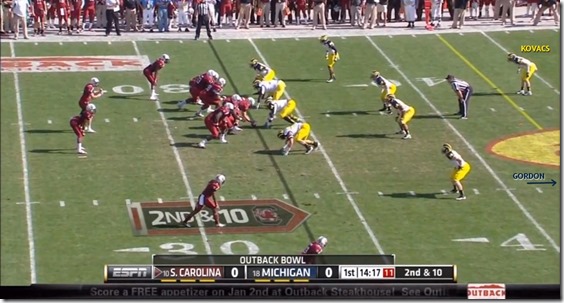


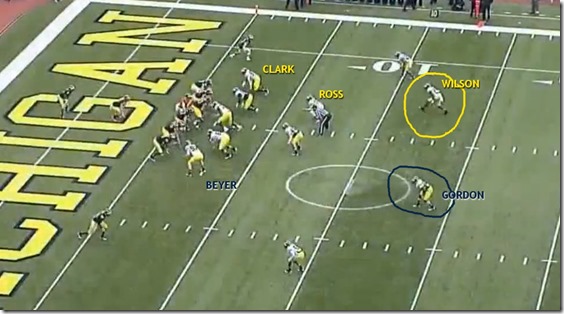

23